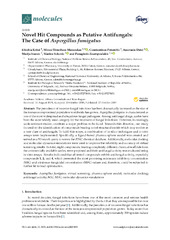Приказ основних података о документу
Novel Hit Compounds as Putative Antifungals: The Case of Aspergillus fumigatus
| dc.creator | Kritsi, Eftichia | |
| dc.creator | Matsoukas, Minos-Timotheos | |
| dc.creator | Potamitis, Constantinos | |
| dc.creator | Detsi, Anastasia | |
| dc.creator | Ivanov, Marija | |
| dc.creator | Soković, Marina | |
| dc.creator | Zoumpoulakis, Panagiotis | |
| dc.date.accessioned | 2019-11-13T11:14:22Z | |
| dc.date.available | 2019-11-13T11:14:22Z | |
| dc.date.issued | 2019 | |
| dc.identifier.uri | https://www.mdpi.com/1420-3049/24/21/3853 | |
| dc.identifier.uri | https://radar.ibiss.bg.ac.rs/handle/123456789/3510 | |
| dc.description.abstract | The prevalence of invasive fungal infections has been dramatically increased as the size of the immunocompromised population worldwide has grown. Aspergillus fumigatus is characterized as one of the most widespread and ubiquitous fungal pathogens. Among antifungal drugs, azoles have been the most widely used category for the treatment of fungal infections. However, increasingly, azole-resistant strains constitute a major problem to be faced. Towards this direction, our study focused on the identification of compounds bearing novel structural motifs which may evolve as a new class of antifungals. To fulfil this scope, a combination of in silico techniques and in vitro assays were implemented. Specifically, a ligand-based pharmacophore model was created and served as a 3D search query to screen the ZINC chemical database. Additionally, molecular docking and molecular dynamics simulations were used to improve the reliability and accuracy of virtual screening results. In total, eight compounds, bearing completely different chemical scaffolds from the commercially available azoles, were proposed and their antifungal activity was evaluated using in vitro assays. Results indicated that all tested compounds exhibit antifungal activity, especially compounds 1, 2, and 4, which presented the most promising minimum inhibitory concentration (MIC) and minimum fungicidal concentration (MFC) values and, therefore, could be subjected to further hit to lead optimization. | en |
| dc.relation | info:eu-repo/grantAgreement/MESTD/Basic Research (BR or ON)/173032/RS// | |
| dc.rights | openAccess | |
| dc.rights.uri | https://creativecommons.org/licenses/by/4.0/ | |
| dc.source | Molecules | |
| dc.subject | Aspergillus fumigatus | |
| dc.subject | Virtual screening | |
| dc.subject | Pharmacophore model | |
| dc.subject | Molecular docking | |
| dc.subject | Antifungal activity | |
| dc.subject | MIC | |
| dc.subject | MFC | |
| dc.subject | Molecular dynamics simulations | |
| dc.title | Novel Hit Compounds as Putative Antifungals: The Case of Aspergillus fumigatus | en |
| dc.type | article | en |
| dc.rights.license | BY | |
| dcterms.abstract | Критси, Ефтицхиа; Матсоукас, Минос-Тимотхеос; Потамитис, Цонстантинос; Детси, Aнастасиа; Соковић, Марина; Зоумпоулакис, Панагиотис; Иванов, Марија; | |
| dc.rights.holder | © 2019 by the authors | |
| dc.citation.issue | 21 | |
| dc.citation.volume | 24 | |
| dc.identifier.doi | 10.3390/molecules24213853 | |
| dc.identifier.scopus | 2-s2.0-85074186672 | |
| dc.identifier.wos | 000498055500042 | |
| dc.citation.apa | Kritsi, E., Matsoukas, M.-T., Potamitis, C., Detsi, A., Ivanov, M., Sokovic, M., et al. (2019). Novel Hit Compounds as Putative Antifungals: The Case of Aspergillus fumigatus. Molecules, 24(21), 3853. | |
| dc.citation.vancouver | Kritsi E, Matsoukas M-T, Potamitis C, Detsi A, Ivanov M, Sokovic M, Zoumpoulakis P. Novel Hit Compounds as Putative Antifungals: The Case of Aspergillus fumigatus. Molecules. 2019;24(21):3853. | |
| dc.citation.spage | 3853 | |
| dc.type.version | publishedVersion | |
| dc.identifier.fulltext | https://radar.ibiss.bg.ac.rs/bitstream/id/5601/Molecules_2019_24_21_3853.pdf | |
| dc.citation.rank | M22 |

